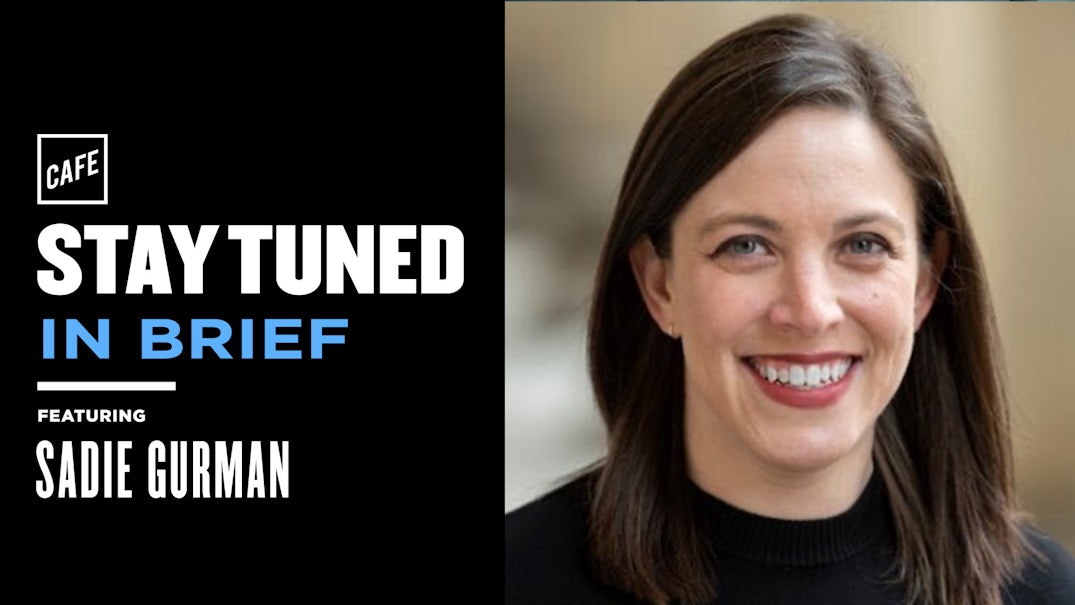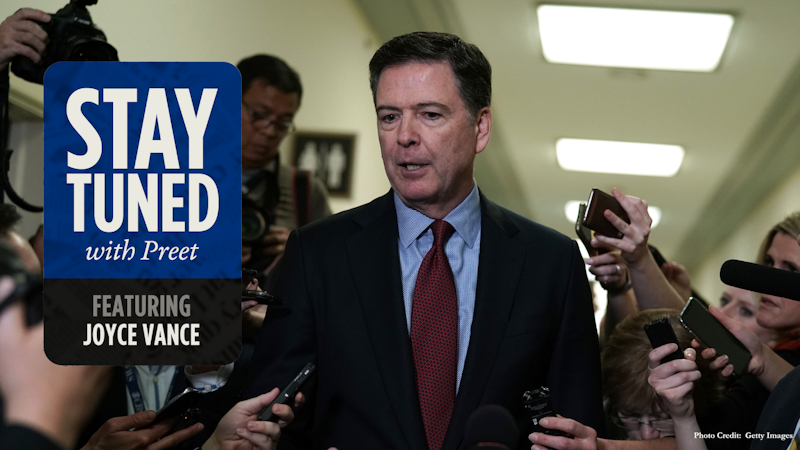Preet Bharara:
From CAFE and the Vox Media Podcast Network, this is Stay Tuned In Brief. I’m Preet Bharara. Today we’re going to talk about one of the most profound and most consequential moral questions that a prosecutor can face; whether to seek the death penalty. In 2021, Attorney General Merrick Garland halted all federal executions pending a review of Trump era policy changes. Now, just under two years later, Garland has withdrawn the death penalty against dozens of defendants while allowing prosecutors to move forward with capital cases in a few select instances. To get a sense of Garland’s thinking and DOJ’s current approach, I’m joined by Sadie Gurman. Sadie covers the Justice Department and federal law enforcement for the Wall Street Journal. Sadie, welcome to the show.
Sadie Gurman:
Thank you for having me.
Preet Bharara:
So I know you’ve been covering this for a while and I’m pleased to have you on. Let’s go back to a few years ago when I was a US Attorney, by the way, I never sought the death penalty and the government had not carried out the death penalty, an execution, in many years, and there were death row inmates who had been convicted, but they just weren’t being put to death. What changed in the Trump administration and with what frequency did the death penalty take place?
Sadie Gurman:
Trump’s first Attorney General Jeff Sessions almost immediately ordered a review of the moratorium that the previous administration had put on executions. And so that signaled that in the Trump administration we were probably going to see some more executions or that we were going to see the death penalty being sought more often. And indeed we did. It would be a couple of years later before the second Attorney General, William Barr, authorized the executions of 13 people over the course of the final six months of the Trump administration. That was the highest number of executions in over a century, and that whittled the number of people on federal death row down to about 44. So it’s certainly a change of approach in this current administration and one that sort of remains to be seen over the rest of the duration.
Preet Bharara:
So there was a 16 or 17-year hiatus, and then in rapid succession, as you point out, 13 executions on the federal level. I know you covered it and outlets covered it, but do you think it got the attention that it deserved? Was there an outcry about it or did it just happen more quietly than you would’ve expected?
Sadie Gurman:
Well, there was, as you know, a lot of stuff going on at the end of the Trump administration that was generating headlines. And so while this did get some attention, I think that perhaps it didn’t quite captivate the way that some of the other stories did, and it kind of got drowned out, I think, by some of the other events that were taking place, but it certainly did capture the attention of rights groups and advocacy organizations that work on behalf of inmates who are particularly horrified by the Trump administration’s approach. So, we saw a lot of last minute petitions to the court to try to halt these things, many of which were unsuccessful.
Preet Bharara:
Yeah. So just to put this in perspective, we’re talking about federal death penalty issues, about 44, as you say, remaining on death row on the federal level as compared to, I think about 2,400 in the various states, is that right?
Sadie Gurman:
That’s right. And that’s a number that’s been declining for the past 20 years. That’s a reflection of declining support for capital punishment, both at the state and federal level. And as a bipartisan matter, more and more people are no longer supporting the death penalty. It’s on the books in 27 states still, but it’s only used in a handful of them, particularly places like Oklahoma and Texas. So, on the whole nationwide, we are seeing a decline in the use of the death penalty.
Preet Bharara:
Is Texas the king of the death penalty in the United States?
Sadie Gurman:
I think that’s right.
Preet Bharara:
So let’s cut to 2021. So Trump is gone, those executions have happened, and Merrick Garland is now the Attorney General and he decides to put a moratorium on all federal executions and to institute a review of what has gone on before. Can you describe for us what that review entails, how it’s supposed to be conducted, and what the result was?
Sadie Gurman:
Well, that review is ongoing. The Attorney General said he did it in part because he had concerns about the arbitrariness in which he felt that capital punishment was being applied. He said he was concerned about the high number of exonerations and also about the disproportionate impact on minority communities. And he was also particularly concerned about the procedures that were in place during the Trump administration, including the methods of execution. So this was kind of a top to bottom review of the death penalty and the department’s policies.
That review is ongoing, but we did see at least one thing emanating from that, and that was a memo written by Deputy Attorney General Lisa Monaco at the end of January that basically told prosecutors they could continue to seek the death penalty, but they should use it in the rarest of circumstances in cases that they believed had the greatest harm on the community and would most negatively impact the federal interest. So that, to me, are things like hate crimes and terrorism cases.
So this memo really sought to sort of slow down what had been a pretty rapid process during the Trump administration, take a more deliberate approach to each case, encourage prosecutors to think about what cases really warrant capital punishment and which ones that are death penalty eligible could be taken off the table and have their time and resources be spent to those really, really egregious cases.
Preet Bharara:
Right. So to remind folks, Merrick Garland in a prior life was himself a federal prosecutor, and in particular, was a person who oversaw the prosecution where death was sought of Timothy McVeigh. Do you have a sense of whether or not that experience has influenced Merrick Garland in this review?
Sadie Gurman:
I think it has. I mean this is one of the first things he talked about when he got onto the job. He said that he didn’t regret seeking the death penalty for McVeigh, and in that specific incident, again, that was a case that had a significant amount of harm on the national interest. It caused harm to the nation, harm to the community, enduring pain, and it was a terrorism case. And so he said he had no regrets about that, but had grown concerned in the 20 years since about the application of the death penalty.
And so I think that just looking at some of the decisions that he’s been making in these cases, it’s clear that he is relying on that instinct as a hardened federal prosecutor who handled some of these pretty grizzly terrorism cases in the past, and I think that is a sensibility that he is applying even as he has taken the death penalty off the table in many different cases.
Preet Bharara:
Explain to folks who may not appreciate this, there’s some things we talk about on the program that are decided by line prosecutors. There are some things that go all the way up to the US attorney. There are other things that also require approval from Washington at some level, to get a wiretap for example. Can you just explain for folks who may not be familiar, how difficult a process it is for there to be the green light to seek the death penalty, not to get the death penalty, that happens in a court and there’s a judge and there’s a jury, but just the decision for the Department of Justice to seek the death penalty, how that looks?
Sadie Gurman:
Yes, that’s one of the more labyrinthine procedures that takes place in the Justice Department and for good reason. I mean it’s one of the most serious and difficult decisions that the Justice Department would have to make; the decision of whether to seek death. And it’s a years-long process oftentimes that starts in the field with recommendations to a committee of other prosecutors who will examine the facts of cases and make a recommendation to the Deputy Attorney General’s Office, which will then refer the matter to the Attorney General.
This, again, takes months and sometimes years of deliberation and includes input from members of the community and even members of the defense in many cases. And the ultimate decision rests with the Attorney General. He is the person who can authorize prosecutors to seek it and who can take it off the table. So it is very individualized depending on which administration and what sensibilities that each Attorney General brings to the table.
Preet Bharara:
Yeah. And give a sense of the timing I mean, I note in your reporting there’s a defendant who I know myself named Nicholas Tartaglione who was arrested on allegations that he engaged in a quadruple homicide when I was the US attorney, and I’ve been out of office for six years and the death penalty was taken off the table by Merrick Garland against Tartaglione, who was a former police officer. Is that typical for the amount of years it takes just to make a decision about the death penalty?
Sadie Gurman:
Yeah. That seems about right. I mean just because there is a moratorium on executions right now doesn’t mean that any of the people who would conceivably be sentenced to death would actually die anytime soon. The case that you mentioned, the Attorney General had sought the death penalty for this person, and as recently as December, the Attorney General took that off of the table. So I think that is pretty typical in these cases, and that’s because there is a lot of post-conviction relief, a lot of chances for inmates to appeal and to make sure that there was nothing wrong or that there was no malfeasance in any of their cases.
So they do have a lot of opportunities to seek recourse. Now, under the past administration, under Attorney General Barr, he examined those. He looked for cases that he felt had exhausted that post-conviction relief. He looked for cases that he thought had been through the court process and were already done. That was a matter of debate between these advocacy groups and the administration, but he did prevail in 13 cases. But this new process just sort of seeks to slow that down even further and make sure that these defendants have exhausted all their options and that the Justice Department’s highest echelons have heard from folks who are looking to have their cases withdrawn or to avoid having the death penalty sought.
Preet Bharara:
Could you give us a couple of other examples of cases where the Attorney General has taken the death penalty off the table?
Sadie Gurman:
Yes, there have been a few sort of gangland-type murders involving multiple victims, things like some MS-13 killings, including killings of witnesses, young witnesses, sometimes as young as 14. There has also been, he took it off the table in the case of a man who murdered a sheriff’s deputy. He also took it off the table in the case of a military official who had killed his wife on federal lands or on a military installation. And there’s an array, there’s 25 cases at least in which the Attorney General has withdrawn a prior seek. So it’s those type of cases where they’re heinous and in one case I think-
Preet Bharara:
But they’re not terrorism.
Sadie Gurman:
Yes. But I mean, in one case, I think a defendant had been charged with killing 11 people over a seven-year span, but he’s looked at the circumstances of each of those cases and apparently thought that they did not warrant the ultimate punishment.
Preet Bharara:
What’s been the reaction from the public and from law enforcement groups who are traditionally hawkish sometimes on the death penalty?
Sadie Gurman:
I think the greatest feeling that I heard from folks in reporting this story out was just confusion. The Attorney General has said he’s applying a very individualized approach to these type of cases, but on the ground level, that doesn’t make a lot of sense to people. Why are you seeking the death penalty in some cases when you’ve put a moratorium on executions? That’s basically a sort of beltway to nowhere according to some of the people who are involved in these cases.
So I think people are just kind of confused about where he stands. It’s also kind of interesting to note that President Biden has also had sort of an evolution on where he stands on the death penalty. He was somebody who in the 90s was very hawkish himself and supported capital punishment, but has now said, as part of a campaign promise, that he wanted to do away with it completely on the federal level and encourage states to do the same. But he hasn’t said very much about that since, and certainly hasn’t taken any action to direct the Attorney General to not seek death anymore. So without a guiding principle, the Attorney General is kind of relying on his own judgment, and that, I think on the ground, is a little bit perplexing to folks.
Preet Bharara:
Can you give some examples of cases where Garland has approved seeking the death penalty? And then also, there have been cases in which the death penalty decision has been defended by this Justice Department?
Sadie Gurman:
Sure. Well to be clear, this Justice Department has not sought the death penalty in any new cases. So we haven’t seen any new cases, but they have continued to pursue the death penalty in at least seven cases, including one playing out in federal court in Manhattan right now against the man who was convicted of killing eight people in a bike path by driving a truck down a bike path, heinous terrorism case.
Preet Bharara:
That happened after my time, after I left office.
Sadie Gurman:
Right. And that was a situation actually in which, it happened in 2017, and former President Trump actually took to Twitter and called for him to be put to death. So it’s interesting to see in that context, this administration continuing to pursue it. But that’s certainly a case where there’s great harm to the national interest.
In contrast, we have the case of the man who killed 23 people in a racist attack at an El Paso Walmart. In that case, the Attorney General told prosecutors not to seek death, even though they had recommended it and he cited the man’s mental illness. If you look at the specifics of each of the cases, it might make more sense, but I think to advocates and certainly to defense attorneys, it is a little bit confusing which ones qualify for that irretrievable penalty.
Preet Bharara:
Right. And then there are the cases of the Boston Marathon bomber, Tsarnaev, and Dylann Roof, the white supremacist who killed nine members of a black church in South Carolina. Those are still winding their way through the courts, and this administration has defended those decisions to seek, am I right?
Sadie Gurman:
That’s right. I think that the Justice Department is defending its decision to seek death against Dylann Roof, who was basically in the late stages of appealing his sentence. There’s also the case of the man who killed 11 people in a Pittsburgh synagogue. That case is supposed to come up for trial in April. That’s a case where the Justice Department has continued to seek the death penalty, even as some of the victim’s families in that case have said they don’t want to see this person put to death. Families seem pretty split in all of these cases. Some of them want to see this and some of them don’t. So that also is not helpful to Garland as he’s trying to make his decision.
Preet Bharara:
Is anything in this review process or that the Attorney General is considering relate to or the findings about the proper method to use in those rare instances where death is sought?
Sadie Gurman:
I think that’s part of the review that’s still underway. Under the Trump administration, there was actually some discussion about using a firing squad, but I think you can only use the method that is authorized in the state. So you would only be able to do that in states that allow a firing squad at the state level. I don’t think that came to pass.
Preet Bharara:
Last question before I let you go, you mentioned earlier in the interview that public sentiment is moving away from the death penalty. Do you see that continuing to be the case, or does it depend on who the president is and who the Attorney General is? And do you think, when we have this conversation in five or 10 years, what do you think the state of play will be?
Sadie Gurman:
Well, what I would say is that public sentiment has been pretty consistently declining in terms of its support for the death penalty publicly. But unless Congress passes a law or the President puts in place an edict or offers clemency to the people who are already on death row, anything that the Attorney General does can be overturned in an administration that is more supportive of the death penalty.
So if this moratorium remains until the end of the Biden administration, if a Republican administration that supports the death penalty comes next, they can totally overturn that. So, we saw this with Derek Holder. He had put a moratorium on the death penalty, and then 13 people were executed in the following administration. So I guess it’s just kind of hard for the Justice Department to operate in a vacuum. It needs Congress to act in order to ultimately end this.
Preet Bharara:
Yeah, look, and it says something about the lack of fairness and inconsistency with respect to defendants who were either put to death or not put to death depending on who the president happens to be, even if the crimes were far in the past. So we’ll be following this some more. Sadie Gurman, thank you for your work on this matter. Thank you for your attention to these very important issues. And thanks for being on the show.
Sadie Gurman:
Thank you so much for your time.
Preet Bharara:
For more analysis of legal and political issues making the headlines, become a member of the CAFE Insider. Members get access to exclusive content, including the weekly podcast I co-host with former US attorney, Joyce Vance. Head to cafe.com/insider to sign up for a trial. That’s cafe.com/insider.
If you like what we do, rate and review the show on Apple Podcasts or wherever you listen. Every positive review helps new listeners find the show. Send me your questions about news, politics, and justice. Tweet them to me, @PreetBharara, with the hashtag, askfree. Or you can call and leave me a message at 669-247-7338. That’s 669-24-PREET, or you can send an email to letters@cafe.com.
Stay Tuned is presented by CAFE and the Vox Media Podcast Network. The executive producer is Tamara Sepper. The technical director is David Tatasciore. The senior producer is Adam Waller. The editorial producers are Sam Ozer-Staton and Noa Azulai. The audio producer is Nat Wiener. And the CAFE team is Matthew Billy, David Kurlander, Jake Kaplan, Namita Shah, and Claudia Hernandez. Our music is by Andrew Dost. I’m your host, Preet Bharara. Stay tuned.

































